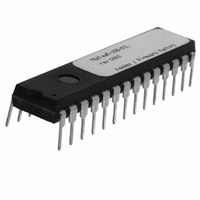TEALEAF-USB-DIL Flexipanel, TEALEAF-USB-DIL Datasheet - Page 4

TEALEAF-USB-DIL
Manufacturer Part Number
TEALEAF-USB-DIL
Description
IC ENCRYPT KEY 28-DIL
Manufacturer
Flexipanel
Datasheet
1.TEALEAF-USB.pdf
(8 pages)
Specifications of TEALEAF-USB-DIL
Tool Type
License Dongle
Lead Free Status / RoHS Status
Lead free / RoHS Compliant
Other names
658-1029-5
Device Evaluation, Hardware Security Keys
Figure 2 is the suggested circuit when initially evaluating
USB-232, and for implementing basic hardware security
keys.
The pushbutton circuits allow you to apply logic 1 or
logic 0 to input pins. The LED circuits allow you to view
the state of output pins. As shown they are active low.
For commercial applications these circuits need only be
provided if required.
Oscillator X1/C2/C3 may be replaced by a low-cost
resonator, provided its frequency tolerance is greater
than 1.5%. C1 and C6 should be placed close to the
USB connector. C7 should be placed near the Vss and
Vdd pins of the TEAleaf-USB and is required only if it
would be some distance from C6. C8 is a filter capacitor
for an internal regulator and is required.
The TEAclipper connector is for in-circuit programming
of devices where the firmware has been purchased from
HexWax. It is recommended to allow firmware updates,
even if the firmware is initially supplied pre-programmed.
Power Take-Off
Figure 3 is the suggested circuit when additionally using
the USB as a source of power for other purposes. C4 /
R6 provide a slow switch-on to prevent inrush current
exceeding USB power limitations.
The AllSysGo# output is used to switch on the power
when the host permits power to be drawn. It will stay on
unless the computer goes into a sleep state. The Low
Pwr output indicates how much power the device may
draw from the USB bus. R1 ensures that T1 does not
switch on while TEAleaf-USB is initializing.
Pay-Per-Use Circuit
The device can be used to control unlock hardware in
pay-per-use applications. In this scenario, software on
the PC host establishes that usage has been granted
(e.g. by a web server) before entering the authentication
process.
p4 of 8
Figure 3
C8
Vdd
Vss
Vdd
LowPwr
C7
Vusb
TEAclipper
connector
C6
26-Aug-10
R1
C4
C1
AllSysGo#
R6
1
TEAleaf-USB
2
R2
3
T1
4
5
Vss
OSC2
OSC1
D+
D-
Vout
Vdd
Vss
X1
C3
C2
TEAleaf-USB
4
3
2
1
Vss
USB
The Auth output can then be used to unlock the device.
This would be relatively easy to ‘hotwire’ electrically, so
contact us if you are interested in this feature being
made more secure.
Power considerations
Initially, the device will request the full power it is
configured for. If it is not granted this power level within
three seconds, it performs a soft detach and requests a
maximum of 100mA. This allows devices to operate in a
low power mode when connected to an unpowered hub.
This reduced power mode is indicated by the Low Pwr
Indication pin.
When designing self powered circuits, ensure power is
never be fed into the Vdd USB line.
AN1149 from Microchip Technology, in the development
kit, discusses designs for recharging batteries using
USB bus power.
If the device is electromagnetically noisy, a ferrite bead
is recommended on the USB Vdd supply in order to
suppress any transmission of noise to the rest of the
USB network.
USB Connectors
Common USB connector and cable configurations are
shown in figure 4 and table 4.
connector should be left unconnected. The ID pin on
the mini connector permits the distinction of A and B
plugs. The micro connector pin-out is the same as the
mini connector.
For ultra-low cost products, it is possible to form a USB
Type-A plug direct from a circuit board as shown in
figure 5. This connector is only suitable for a number of
insertions (~50 before cleaning is required).
unshielded and recommended only for ‘dongle’ type
products with no cables attached.
Std Mini
1
2
3
–
4
Pin
HW146-8
1
2
3
4
5
Figure 4 Common USB pin-outs for male connectors
Name
Gnd
Vcc
D+
D–
ID
Table 4. USB Connection Key
Cable
Green
color
White
Black
Red
–
Description
+5V (can dip to 4.08V)
Data –
Data +
Type A: Connect to ground
Type B: Not connected
Signal ground
www.firmwarefactory.com
The shield on the
Design note
It is






















